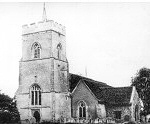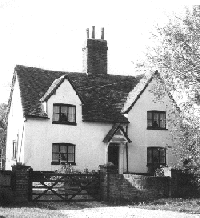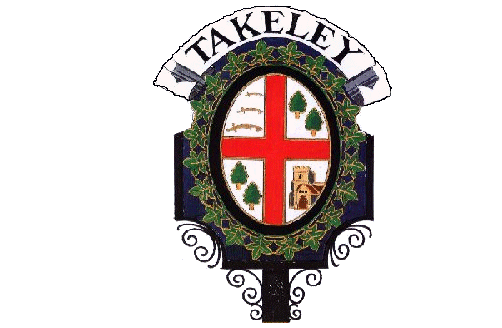|
Adapted from "Takeley A History" last published by Mr A L Frost (Les) in 1983.

The village though not noted for its beauty yet has some buildings of great historic interest, notably the very beautiful Church of Holy Trinity. This has a 12th century nave and a 15th century tower.
In the north wall can be seen some red Roman paving tiles, probably pieces of the original Stane Street.
The Church once had a wooden spire of the type common in East Anglia. This was struck by lightning in 1928, set on fire and destroyed. A striking feature of the interior is a 16th century decorated font cover. The finely carved screen also catches the eye.
During the incumbency of Rev W H Branch 1962-1974 over £7,000 was spent on the restoration of the Church, and the result is delightful. Takeley was always an attractive church; it is now a beautiful one.
Church registers, apart from the list of Vicars, unfortunately go back only to the 17th century. However much interesting information can be found therein. Local surnames such as Gunn, Reynolds, Salmon and Prior go back as far as the records. Another striking feature of earlier years is the appalling infant mortality due no doubt to epidemics of infectious diseases. There are also long lists of deaths in1665, the year of the Great Plague.
Much of the land in Takeley was owned by various local religious foundations, from which it passed to New College, Oxford until 1899 when most of it was sold off to its tenants.
Another building of great interest is Warish Hall, a fine moated manor house just beyond Smith's Green. This was once a monastery, St. Valery's Priory, and is said to have been founded by the Normans in gratitude for their victory at Hastings in 1066. The story is that William of Normandy collected his fleet for the invasion but was unable to sail because of adverse winds. So he went to the nearby shrine of St. Valery, a French saint, and prayed for help. Soon the wind changed, the invasion fleet sailed, landed near Hastings and defeated the Anglo Saxons at Senlac Hill.
When Henry VIII broke with Rome in 1534 he set about to destroy the power of the Church of Rome in England. So the monasteries were dissolved, some like that at Hatfield Broad Oak became parish churches, some the first grammar schools and others like Warish Hall became moated manor houses.
Other properties originally connected with religious orders are Colchester Hall, an offshoot of the Abbey of St. John in Colchester, Waltham Hall (Waltham Abbey) and Bassingbourn. Rumour has it that a secret passage runs from Bassingbourn to Takeley Church, but of this I find no proof. It is however, significant that the South Aisle of the Church is known as the Bassingbourn Chapel.
Another house of great interest is The Grange, originally called Tilty Grange because it belonged to the nearby Tilty Abbey. After lying derelict for many years, the house was beautifully restored by Dr J Fairley.
Just outside the parish boundary is Great Canfield Park, the home of Lt Col R W G and Mrs Charlton. This deserves mention not only because of the history of the house, but also because of the long association of the Charlton family with the village of Takeley.
Canfield Park is a I5th century manor house which originated as a hunting lodge in a deer park. The Earl of Oxford who owned much land hereabouts built it in 1456. The property changed hands several times until acquired by the Maynard family in the 17th century. It remained in their hands for 300 years and was bought in 1928 by the late General Claud Charlton, High Sheriff of Essex, 1947-48.
Adapted from "Takeley A History, New Edition 2000" by Trevor J Allen, Village Historian.
The very beautiful church of the Holy Trinity has been spared any disastrous consequences of airport development. In 1999 funding was raised to restore the roof of the Lady Chapel (the south aisle) and there are plans for an inclusion of an inside toilet. During 1998/99 the church became the proud owner of 120 kneelers, these kneelers were hand-embroidered by members of the congregation and friends. Each one of them bears a personal dedication.
Of the three important sites mentioned in the Domesday Book, Warish Hall (St Valery Priory) is the only site that was not affected by the expansion of Stansted Airport. Colchester Hall was demolished in 1987 and is now covered by the aircraft apron and second departure lounge while the Bassingbourn Hall site was cleared in the 1990s and the site covered by the airport. However all the bricks, timbers, barns and engine building from Bassingbourn Hall were carefully saved, and removed to the nearby historical building museum at Toppesfield.
Before these sites were demolished, as much excavation was carried out as possible in the time allowed. Rather disappointingly it was discovered that because of continuous occupation over many centuries it was impossible to date their origin with any certainty.
Of other Medieval sites demolished, Great Coopers (pictured below) was taken down brick by brick and re-built by private owners at Battlesbridge, south of Chelmsford. The Barns at Great Coopers were also preserved and removed to Toppesfield.
 Little Coopers was systematically dismantled and re-built at the Watt Tyler open air museum site in Basildon. Blunt's Cottage was also re-built there. Little Coopers was systematically dismantled and re-built at the Watt Tyler open air museum site in Basildon. Blunt's Cottage was also re-built there.
At Brewers End changes to two historic buildings have not been due to anything other than the passage of time.
The Chestnuts, an attractive timber-built house, which was in danger of becoming derelict, was restored as a commercial premises, perhaps making up in safety and permanence what was lost in appearance. The Chestnuts has had a chequered existence, having been a general store and post office, a café and antique shop.
Mr Felix Cobbson bought the Old Rectory ‘Takeley House' in 1977, as part of a charitable organisation known as Aklowa, an African Heritage Village. Aklowa's main aim is to promote the understanding of African culture through the study of and participation in music, dance and the arts of Africa with Ghana in particular. It is open to all groups and is regularly visited by schools from all over the country.
The most recent reconstruction has been to the substantial family house called Lumsdale. Standing next to the chapel, the property was built in 1853, for a prosperous family in the straw and fodder trade. It has been rescued from dilapidation and is now occupied. Lt Col R W G and Mrs Charlton have sold Canfield Park, but still maintain their links with the village, having moved to Hatfield Broad Oak.
Copies of "Takeley A History, New Edition 2000" can be obtained from the TLHS Secretary at a price of £5 including p&p within the UK.
|



